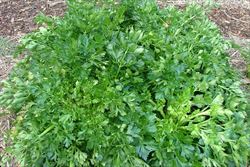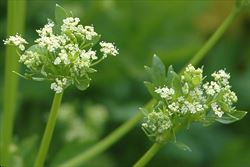Click on images to enlarge

habit prior to flowering (Photo: Sheldon Navie)

habit in flower (Photo: Rob and Fiona Richardson)

deeply-divided leaves with fleshy stalks (Photo: Sheldon Navie)

compound flower cluster, with branches of unequal lengths (Photo: Rob and Fiona Richardson)

close-up of flowering stem, showing several branches radiating from the same point (Photo: Rob and Fiona Richardson)

close-up of flower clusters (Photo: Rob and Fiona Richardson)

young plant (Photo: Sheldon Navie)

habit of celeriac (Apium graveolens var. rapaceum), which can be distinguished from garden celery (Apium graveolens var. dulce) by its swollen taproot (Photo: Sheldon Navie)
Scientific Name
Apium graveolens L.
Family
Apiaceae (Queensland, New South Wales, the ACT, Victoria, Tasmania, Western Australia and the Northern Territory)Umbelliferae (South Australia)
Common Names
celery, garden celery, wild celery
Origin
Native to Europe, northern Africa and western Asia.
Naturalised Distribution
Widely naturalised, particularly in the temperate regions of south-eastern Australia. It is most commonly naturalised in southern and eastern New South Wales, Victoria and south-eastern South Australia. Occasionally naturalised in south-western Western Australia, in south-eastern Queensland, in other parts of South Australia and in the southern parts of the Northern Territory. Also naturalised on Lord Howe Island and Norfolk Island, and possibly naturalised in Tasmania.
Notes
Wild celery (Apium graveolens) is regarded as an environmental weed in Western Australia and Victoria. This species has escaped from cultivation as a vegetable, and has become a weed in some wetter natural habitats. It mainly becomes naturalised in wetlands and along waterways in temperate regions, but has also been recorded from similar habitats in more arid inland areas.
In most areas wild celery (Apium graveolens) is regarded as a relatively minor environmental weed. However, in Victoria, this species is seen as a potential threat to one or more vegetation formations and is listed as a high threat weed species in brackish wetlands in the Glenelg Plain bioregion. It also appears on the local environmental weed list for the Mornington Peninsula Shire and has been recorded in Yarra Bend Park in suburban Melbourne.
In south-western Western Australia it grows along the edges of drainage channels and has also been recorded from the margins of Lake Joondalup. In New South Wales wild celery (Apium graveolens) is naturalised is the Picton-Campbelltown area and near Lake Cargelligo. It has also been recorded in several conservation areas in South Australia (i.e. Lake Frome Conservation Park, Scott Creek Conservation Park, Sturt Gorge Recreation Park, Morialta Conservation Park, Cudlee Creek Conservation Park and Onkaparinga River National Park).

